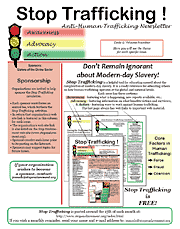San Jose Police Department, CA
Home MenuHuman Trafficking Task Force
Scope of the Problem
Trafficking in persons is a modern day form of slavery. According to the 2005 Trafficking in Persons Report, 600,000 to 800,000 people are trafficked across international borders each year. The United States Department of Justice estimates 18,000 to 20,000 people are trafficked into the United States each year. Internationally, there are many groups working to combat human trafficking. The United States is a recent entrant to this struggle. Aside from producing the most comprehensive analysis of trafficking in persons, the United States has been successful in encouraging countries with trafficking problems to take action against it.
Email: StopSlavery@sanjoseca.gov
Victims of Trafficking Have Rights
No one can legally force a person to work against his or her will. Victims of trafficking in the United States are entitled to protection and assistance, including:
- Information about their rights
- Access to translation/interpretation
- Free or low-cost legal services Federal and state benefits
Human Trafficking is a Crime Under the United States Law
The Trafficking Victim Protection Act (TVPA) passed in 2000, served to broaden the definition of trafficking to include a wide array of exploitation, defining severe forms of human trafficking as:
-
Sex trafficking in which a commercial sex act is induced by force, fraud, or coercion, or in which the person induced to perform such an act has not attained 18 years of age; or
-
The recruitment, harboring, transportation, provision, or obtaining of a person for labor or services, through the use of force, fraud, or coercion for the purpose of subjection to involuntary servitude, peonage, debt bondage, or slavery.
Who is Trafficked
Men, women, and children can fall victim to human trafficking. Trafficked persons originate from countries around the world but can also be United States citizens. They are forced to work in the sex industry or in labor situations such as domestic servitude, manufacturing, construction or migrant agricultural work.
Where to Find Victims
Throughout the United States and more specifically Santa Clara County, we have only scratched the surface in terms of identifying victims of trafficking. In order to properly identify victims, it is important to remember that victims are not always transported from abroad, but that they may also be United States citizens, or victims being domestically trafficked.
Important Questions to Ask
What to ask when you suspect a person is a victim of human trafficking.
- Stop Human Trafficking
- What type of work do you do?
- Are you being paid?
- Can you leave your job if you want to?
- Can you come and go as you please?
- Have you or your family been threatened?
- What are your working or living conditions like?
- Where do you sleep and eat?
- Are there locks on your doors or windows so you cannot get out?
- Do you have to ask permission to eat, sleep, go to the bathroom?
- Has your identification or documentation been taken from you?
 Additional Resources
Additional Resources
- Learn about Anti-Human Trafficking Current Issues.
- Sign up to receive the Anti-Human Trafficking Newsletter or become a sponsor.
Important Phone Numbers:
- SJPD Human Trafficking Task Force Nat'l Hot-Line: 888-373-7888
- Federal Bureau of Investigation: (408) 369 - 8900
- United States Bureau of Immigration and Customs Enforcement: 866-DHS-2-ICE
- Community Solutions - 24 Hour Crisis Line: (408) 683-4118
- Next Door Solutions to Domestic Violence - 24 Hour Crisis Line: (408) 279-2962
Related Links:
- SJPD Vice - Intel Unit
- Anti-Human Trafficking Task Force Strategy and Operations e-Guide
- Bay Area Anti-Trafficking Coalition
- Blue Campaign, Department of Homeland Security
- Department of Health and Human Services Rescue and Restore Campaign
- Federal Bureau of Investigation
- Polaris Project
- South Bay Coalition to End Human Trafficking (SBCEHT)
- United States Dept. of Justice
- United States Department of State
